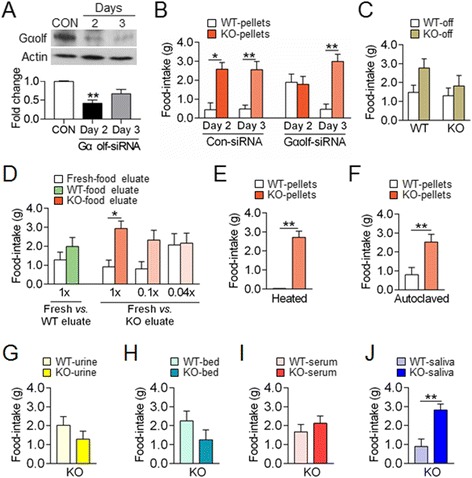Figure 2.

AC5 KO mice produced behavioral preferences for KO pellets based on an olfactory cue-directed option. (A, B) Western blots showing the siRNA-mediated down-regulation of the Gαolf levels in the olfactory epithelium in WT mice and their quantification (A). Blocking of the preferred choices for KO food pellets in AC5 KO mice after the infusion of Gαolf-siRNA into the olfactory epithelium (B, C) Behavioral choices of AC5 KO mice for KO pellets vs. WT pellets whose surfaces were peeled off. (D) Behavioral choices of AC5 KO mice for fresh pellet pasted with KO-food eluate vs. fresh-food eluate at gradually diluted concentrations and for fresh pellet pasted with WT-food eluate vs. fresh-food eluate. (E, F) Behavioral choices of AC5 KO mice for WT pellets vs. KO pellets that were heated (E) or autoclaved (F). (G-J) Behavioral choices of AC5 KO mice for food pellets that were pasted with WT urine vs. KO urine (G), for food pellets that were mingled with WT bed vs. KO bed (H), for food pellets that were pasted with WT serum vs. KO serum (I), and for food pellets that were pasted with WT saliva vs. KO saliva (J). Data were mean ± SEM (n = 7-12). * and ** denote the difference between indicated groups at p <0.05 and p <0.01, respectively. One-way ANOVA, Tukey's HSD post hoc test (A), Two-way repeated measures ANOVA, Holm-Sidak post hoc test (B), Two-way ANOVA and Tukey's HSD post hoc test (C, D), and Student t-test (D, E-J) were used.
